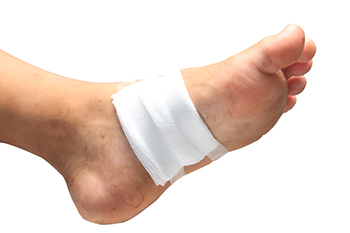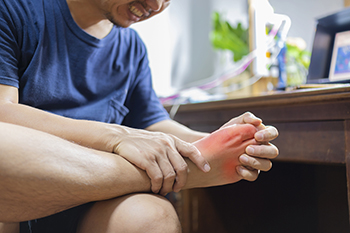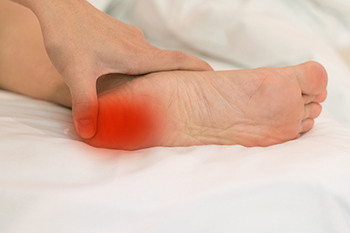Items filtered by date: October 2024
How Diabetes Affects Wound Healing

Diabetes can significantly impair wound healing, particularly in the feet, where the risk of complications is higher. Elevated blood glucose levels in diabetic patients disrupt vital healing processes that delay tissue repair. For instance, diabetes often leads to poor circulation, which reduces oxygen and nutrient delivery to wound sites and further slows healing. Diabetic neuropathy, or nerve damage, makes it difficult for patients to feel foot injuries, which allows wounds to go untreated and increases the risk of infection. Meanwhile, the immune system is often weakened by this disease, making it harder for the body to fight infections that can further delay healing. Regular foot checks and early intervention are essential to managing foot wounds for people who are diabetic. If you have foot wounds that will not heal, it is suggested that you include a podiatrist as part of your medical team for treatment.
Wound care is an important part in dealing with diabetes. If you have diabetes and a foot wound or would like more information about wound care for diabetics, consult with one of our podiatrists from Itasca Foot & Ankle. Our doctors will assess your condition and provide you with quality foot and ankle treatment.
What Is Wound Care?
Wound care is the practice of taking proper care of a wound. This can range from the smallest to the largest of wounds. While everyone can benefit from proper wound care, it is much more important for diabetics. Diabetics often suffer from poor blood circulation which causes wounds to heal much slower than they would in a non-diabetic.
What Is the Importance of Wound Care?
While it may not seem apparent with small ulcers on the foot, for diabetics, any size ulcer can become infected. Diabetics often also suffer from neuropathy, or nerve loss. This means they might not even feel when they have an ulcer on their foot. If the wound becomes severely infected, amputation may be necessary. Therefore, it is of the upmost importance to properly care for any and all foot wounds.
How to Care for Wounds
The best way to care for foot wounds is to prevent them. For diabetics, this means daily inspections of the feet for any signs of abnormalities or ulcers. It is also recommended to see a podiatrist several times a year for a foot inspection. If you do have an ulcer, run the wound under water to clear dirt from the wound; then apply antibiotic ointment to the wound and cover with a bandage. Bandages should be changed daily and keeping pressure off the wound is smart. It is advised to see a podiatrist, who can keep an eye on it.
If you have any questions, please feel free to contact our offices located in Itasca and Hoffman Estates, IL . We offer the newest diagnostic and treatment technologies for all your foot care needs.
Pickleball and Ankle Sprains

Pickleball is an enjoyable sport that can lead to injuries, particularly ankle sprains. Ankle sprains occur when ligaments are stretched or torn, often due to sudden movements. There are two primary types of ankle sprains known as inversion and eversion. Inversion sprains happen when the foot rolls inward, causing damage to the ligaments on the outer side of the ankle. Eversion sprains occur when the foot rolls outward, affecting the ligaments on the inner side. Both types can result in pain, swelling, and limited mobility. It is essential for players to engage in proper warm-up routines and wear appropriate footwear to minimize the risk of these injuries. Strengthening exercises for the ankles can also help improve stability. If you have endured an ankle sprain from playing pickleball, it is suggested that you consult a podiatrist who can effectively treat this injury.
Sports related foot and ankle injuries require proper treatment before players can go back to their regular routines. For more information, contact one of our podiatrists of Itasca Foot & Ankle. Our doctors can provide the care you need to keep you pain-free and on your feet.
Sports Related Foot and Ankle Injuries
Foot and ankle injuries are a common occurrence when it comes to athletes of any sport. While many athletes dismiss the initial aches and pains, the truth is that ignoring potential foot and ankle injuries can lead to serious problems. As athletes continue to place pressure and strain the area further, a mild injury can turn into something as serious as a rupture and may lead to a permanent disability. There are many factors that contribute to sports related foot and ankle injuries, which include failure to warm up properly, not providing support or wearing bad footwear. Common injuries and conditions athletes face, including:
- Plantar Fasciitis
- Plantar Fasciosis
- Achilles Tendinitis
- Achilles Tendon Rupture
- Ankle Sprains
Sports related injuries are commonly treated using the RICE method. This includes rest, applying ice to the injured area, compression and elevating the ankle. More serious sprains and injuries may require surgery, which could include arthroscopic and reconstructive surgery. Rehabilitation and therapy may also be required in order to get any recovering athlete to become fully functional again. Any unusual aches and pains an athlete sustains must be evaluated by a licensed, reputable medical professional.
If you have any questions please feel free to contact our offices located in Itasca and Hoffman Estates, IL . We offer the newest diagnostic and treatment technologies for all your foot and ankle needs.
Are You Suffering From Ingrown Toenails?
What You Need to Know About Gout

Gout is a form of arthritis caused by the accumulation of uric acid crystals in the joints. It often affects the feet and results in severe pain, redness, swelling, and stiffness. Gout commonly affects the big toe, but it can also target the ankles and any of the many other foot joints. Gout can be triggered by a diet high in purines, which are found in red meats and certain seafood. Alcohol consumption, obesity, and certain medications are other common factors. People with a kidney condition or who take diuretics for blood pressure control are at a higher risk. During a gout flare-up, the affected area may become hot and extremely sensitive to touch, making everyday activities challenging. Although gout is not curable, it can be managed with the help of a podiatrist through guidance on minimizing future flare-ups. This may include addressing risk factors, such as dietary habits, and prescribing medication to lower uric acid levels. If you are experiencing flare ups of gout, it is suggested that you schedule an appointment with a podiatrist.
Gout is a foot condition that requires certain treatment and care. If you are seeking treatment, contact one of our podiatrists from Itasca Foot & Ankle. Our doctors will treat your foot and ankle needs.
What Is Gout?
Gout is a type of arthritis caused by a buildup of uric acid in the bloodstream. It often develops in the foot, especially the big toe area, although it can manifest in other parts of the body as well. Gout can make walking and standing very painful and is especially common in diabetics and the obese.
People typically get gout because of a poor diet. Genetic predisposition is also a factor. The children of parents who have had gout frequently have a chance of developing it themselves.
Gout can easily be identified by redness and inflammation of the big toe and the surrounding areas of the foot. Other symptoms include extreme fatigue, joint pain, and running high fevers. Sometimes corticosteroid drugs can be prescribed to treat gout, but the best way to combat this disease is to get more exercise and eat a better diet.
If you have any questions please feel free to contact our offices located in Itasca and Hoffman Estates, IL . We offer the newest diagnostic and treatment technologies for all your foot and ankle needs.
Symptoms of Arthritis in the Toes

Symptoms of arthritis in the toes can vary from mild discomfort to significant pain and swelling. One of the early signs is stiffness, especially in the big toe joint, which can limit movement and make walking difficult. As the condition progresses, toe pain often flares during activities like standing or walking and may persist even after resting. Swelling is another common symptom of arthritis in the toes, making them difficult to bend. You might also notice redness or warmth due to inflammation, in addition to deformities such as bunions or hammertoes, which can affect foot function. In some cases, arthritis leads to creaking sounds in the joints, referred to as crepitus. This can worsen during cold or damp weather and further limit mobility. A podiatrist can evaluate your condition and recommend appropriate ways to help manage pain and improve foot function. If you are experiencing symptoms of arthritis in the toes, it is suggested that you schedule an appointment with a podiatrist.
Toe pain can disrupt your daily activities. If you have any concerns, contact one of our podiatrists of Itasca Foot & Ankle. Our doctors can provide the care you need to keep you pain-free and on your feet.
What Causes Toe Pain?
Most severe toe pain is caused due to a sports injury, trauma from dropping something heavy on the toe, or bumping into something rigid. Other problems can develop over time for various reasons.
Toe pain can be caused by one or more ailments. The most common include:
- Trauma
- Sports injury
- Wearing shoes that are too tight
- Arthritis
- Gout
- Corns and calluses
- Hammertoe
- Bunions
- Blisters
- Ingrown toenails
- Sprains
- Fractures (broken bones)
- Dislocations
When to See a Podiatrist
- Severe pain
- Persistent pain that lasts more than a week
- Signs of infection
- Continued swelling
- Pain that prevents walking
Diagnosis
In many cases the cause of toe pain is obvious, but in others, a podiatrist may want to use more advanced methods to determine the problem. These can range from simple visual inspections and sensation tests to X-rays and MRI scans. Prior medical history, family medical history, and any recent physical traumatic events will all be taken into consideration for a proper diagnosis.
Treatment
Treatments for toe pain and injuries vary and may include shoe inserts, padding, taping, medicines, injections, and in some cases, surgery. If you believe that you have broken a toe, please see a podiatrist as soon as possible.
If you have any questions please feel free to contact our offices located in Itasca and Hoffman Estates, IL . We offer the newest diagnostic tools and technology to treat your foot and ankle needs.
Causes of Heel Pad Syndrome

Heel pad syndrome develops when the fatty tissue beneath your heel loses thickness or elasticity, causing discomfort with every step. This tissue normally serves as a shock absorber, but over time, aging and repetitive stress can cause it to break down. Particular factors that increase heel pad syndrome include running, being overweight, or frequently walking on hard surfaces. The resulting loss of cushioning leads to pain, typically felt in the center of the heel during standing for long periods, walking long distances, or running. A podiatrist can provide relief by prescribing custom orthotics or heel cups to redistribute pressure. Lifestyle changes that decrease stress on the heels and medication to reduce inflammation also help. Early diagnosis and treatment are essential to prevent further complications. If you are experiencing heel pain, it is suggested that you schedule an appointment with a podiatrist for treatment options.
Many people suffer from bouts of heel pain. For more information, contact one of our podiatrists of Itasca Foot & Ankle. Our doctors can provide the care you need to keep you pain-free and on your feet.
Causes of Heel Pain
Heel pain is often associated with plantar fasciitis. The plantar fascia is a band of tissues that extends along the bottom of the foot. A rip or tear in this ligament can cause inflammation of the tissue.
Achilles tendonitis is another cause of heel pain. Inflammation of the Achilles tendon will cause pain from fractures and muscle tearing. Lack of flexibility is also another symptom.
Heel spurs are another cause of pain. When the tissues of the plantar fascia undergo a great deal of stress, it can lead to ligament separation from the heel bone, causing heel spurs.
Why Might Heel Pain Occur?
- Wearing ill-fitting shoes
- Wearing non-supportive shoes
- Weight change
- Excessive running
Treatments
Heel pain should be treated as soon as possible for immediate results. Keeping your feet in a stress-free environment will help. If you suffer from Achilles tendonitis or plantar fasciitis, applying ice will reduce the swelling. Stretching before an exercise like running will help the muscles. Using all these tips will help make heel pain a condition of the past.
If you have any questions please contact our offices located in Itasca and Hoffman Estates, IL . We offer the newest diagnostic and treatment technologies for all your foot and ankle needs.
